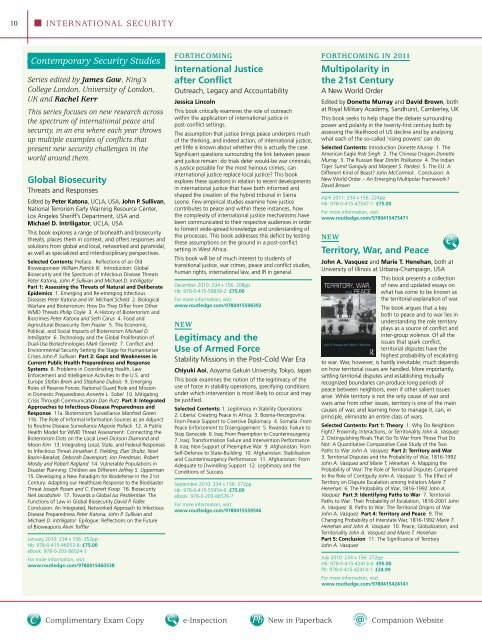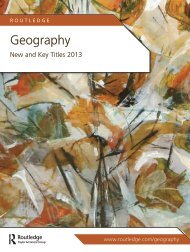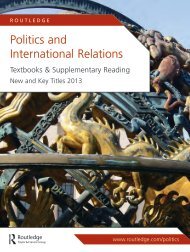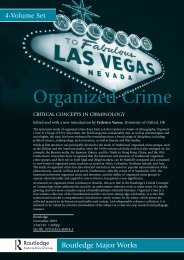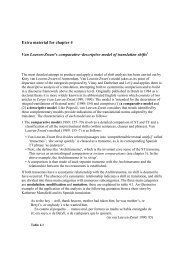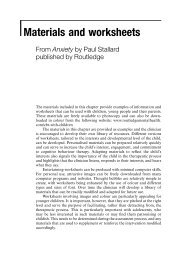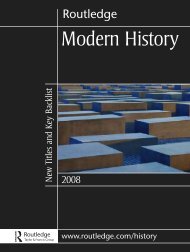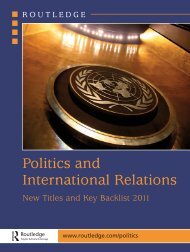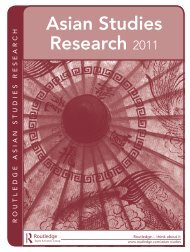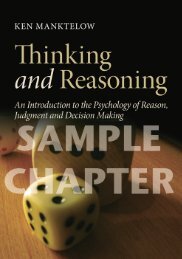Easily na - Routledge
Easily na - Routledge
Easily na - Routledge
You also want an ePaper? Increase the reach of your titles
YUMPU automatically turns print PDFs into web optimized ePapers that Google loves.
10<br />
iNTerNaTioNal seCuriTy<br />
Contemporary Security Studies<br />
Series edited by James Gow, King’s<br />
College London, University of London,<br />
UK and Rachel Kerr<br />
This series focuses on new research across<br />
the spectrum of inter<strong>na</strong>tio<strong>na</strong>l peace and<br />
security, in an era where each year throws<br />
up multiple examples of conflicts that<br />
present new security challenges in the<br />
world around them.<br />
Global Biosecurity<br />
Threats and Responses<br />
Edited by Peter Kato<strong>na</strong>, UCLA, USA, John P. Sullivan,<br />
Natio<strong>na</strong>l Terrorism Early Warning Resource Center,<br />
Los Angeles Sheriff’s Department, USA and<br />
Michael D. Intriligator, UCLA, USA<br />
This book explores a range of biohealth and biosecurity<br />
threats, places them in context, and offers responses and<br />
solutions from global and local, networked and pyramidal,<br />
as well as specialized and interdiscipli<strong>na</strong>ry perspectives.<br />
Selected Contents: Preface. Reflections of an Old<br />
Bioweaponeer William Patrick III. Introduction: Global<br />
Biosecurity and the Spectrum of Infectious Disease Threats<br />
Peter Kato<strong>na</strong>, John P. Sullivan and Michael D. Intriligator<br />
Part 1: Assessing the Threats of Natural and Deliberate<br />
Epidemics 1. Emerging and Re-emerging Infectious<br />
Diseases Peter Kato<strong>na</strong> and W. Michael Scheld 2. Biological<br />
Warfare and Bioterrorism: How Do They Differ from Other<br />
WMD Threats Philip Coyle 3. A History of Bioterrorism and<br />
Biocrimes Peter Kato<strong>na</strong> and Seth Carus 4. Food and<br />
Agricultural Biosecurity Tom Frazier 5. The Economic,<br />
Political, and Social Impacts of Bioterrorism Michael D.<br />
Intriligator 6. Technology and the Global Proliferation of<br />
Dual-Use Biotechnologies Mark Gorwitz 7. Conflict and<br />
Environmental Security Setting the Stage for Humanitarian<br />
Crises John P. Sullivan Part 2: Gaps and Weaknesses in<br />
Current Public Health Preparedness and Response<br />
Systems 8. Problems in Coordi<strong>na</strong>ting Health, Law<br />
Enforcement and Intelligence Activities in the U.S. and<br />
Europe Stefan Brem and Stéphane Dubois 9. Emerging<br />
Roles of Reserve Forces: Natio<strong>na</strong>l Guard Role and Mission<br />
in Domestic Preparedness Annette L. Sobel 10. Mitigating<br />
Crisis Through Communication Dan Rutz Part 3: Integrated<br />
Approaches to Infectious-Disease Preparedness and<br />
Response 11a. Bioterrorism Surveillance Manfred Green<br />
11b. The Role of Informal Information Sources as an Adjunct<br />
to Routine Disease Surveillance Majorie Pollack 12. A Public<br />
Health Model for WMD Threat Assessment: Connecting the<br />
Bioterrorism Dots on the Local Level Dickson Diamond and<br />
Moon Kim 13. Integrating Local, State, and Federal Responses<br />
to Infectious Threat Jo<strong>na</strong>than E. Fielding, Elan Shultz, Noel<br />
Bazini-Barakat, Deborah Davenport, Jon Freedman, Robert<br />
Mosby and Robert Ragland 14. Vulnerable Populations in<br />
Disaster Planning: Children are Different Jeffrey S. Upperman<br />
15. Developing a New Paradigm for Biodefense in the 21st<br />
Century: Adapting our Healthcare Response to the Biodisaster<br />
Threat Joseph Rosen and C. Everett Koop 16. Biosecurity<br />
Neil Jacobstein 17. Towards a Global Ius Pestilentiae: The<br />
Functions of Law in Global Biosecurity David P. Fidler.<br />
Conclusion: An Integrated, Networked Approach to Infectious<br />
Disease Preparedness Peter Kato<strong>na</strong>, John P. Sullivan and<br />
Michael D. Intriligator Epilogue: Reflections on the Future<br />
of Bioweapons Alvin Toffler<br />
January 2010: 234 x 156: 352pp<br />
Hb: 978-0-415-46053-8: £75.00<br />
eBook: 978-0-203-86024-3<br />
For more information, visit:<br />
www.routledge.com/9780415460538<br />
Forthcoming<br />
Inter<strong>na</strong>tio<strong>na</strong>l Justice<br />
after Conflict<br />
Outreach, Legacy and Accountability<br />
Jessica Lincoln<br />
This book critically examines the role of outreach<br />
within the application of inter<strong>na</strong>tio<strong>na</strong>l justice in<br />
post-conflict settings.<br />
The assumption that justice brings peace underpins much<br />
of the thinking, and indeed action, of inter<strong>na</strong>tio<strong>na</strong>l justice,<br />
yet little is known about whether this is actually the case.<br />
Significant questions surrounding the link between peace<br />
and justice remain: do trials deter would-be war crimi<strong>na</strong>ls;<br />
is justice possible for the most heinous crimes; can<br />
inter<strong>na</strong>tio<strong>na</strong>l justice replace local justice? This book<br />
explores these questions in relation to recent developments<br />
in inter<strong>na</strong>tio<strong>na</strong>l justice that have both informed and<br />
shaped the creation of the hybrid tribu<strong>na</strong>l in Sierra<br />
Leone. Few empirical studies examine how justice<br />
contributes to peace and within these instances, how<br />
the complexity of inter<strong>na</strong>tio<strong>na</strong>l justice mechanisms have<br />
been communicated to their respective audiences in order<br />
to foment wide-spread knowledge and understanding of<br />
the processes. This book addresses this deficit by testing<br />
these assumptions on the ground in a post-conflict<br />
setting in West Africa.<br />
This book will be of much interest to students of<br />
transitio<strong>na</strong>l justice, war crimes, peace and conflict studies,<br />
human rights, inter<strong>na</strong>tio<strong>na</strong>l law, and IR in general.<br />
December 2010: 234 x 156: 208pp<br />
Hb: 978-0-415-59839-2: £75.00<br />
For more information, visit:<br />
www.routledge.com/9780415598392<br />
new<br />
Legitimacy and the<br />
Use of Armed Force<br />
Stability Missions in the Post-Cold War Era<br />
Chiyuki Aoi, Aoyama Gakuin University, Tokyo, Japan<br />
This book examines the notion of the legitimacy of the<br />
use of force in stability operations, specifying conditions<br />
under which intervention is most likely to occur and may<br />
be justified.<br />
Selected Contents: 1. Legitimacy in Stability Operations<br />
2. Liberia: Creating Peace in Africa 3. Bosnia-Herzegovi<strong>na</strong>:<br />
From Peace Support to Coercive Diplomacy 4. Somalia: From<br />
Peace Enforcement to Disengagement 5. Rwanda: Failure to<br />
Stop Genocide 6. Iraq: From Preemption to Counterinsurgency<br />
7. Iraq: Transformation Failure and Intervention Performance<br />
8. Iraq: Non-Support of Preemptive War 9. Afghanistan: From<br />
Self-Defence to State-Building 10. Afghanistan: Stabilisation<br />
and Counterinsurgency Performance 11. Afghanistan: From<br />
Adequate to Dwindling Support 12. Legitimacy and the<br />
Conditions of Success<br />
September 2010: 234 x 156: 272pp<br />
Hb: 978-0-415-55954-6: £75.00<br />
eBook: 978-0-203-86576-7<br />
For more information, visit:<br />
www.routledge.com/9780415559546<br />
Forthcoming in 2011<br />
Multipolarity in<br />
the 21st Century<br />
A New World Order<br />
Edited by Donette Murray and David Brown, both<br />
at Royal Military Academy, Sandhurst, Camberley, UK<br />
This book seeks to help shape the debate surrounding<br />
power and polarity in the twenty-first century both by<br />
assessing the likelihood of US decline and by a<strong>na</strong>lysing<br />
what each of the so-called ’rising powers’ can do.<br />
Selected Contents: Introduction Donette Murray 1. The<br />
American Eagle Rob Singh 2. The Chinese Dragon Donette<br />
Murray 3. The Russian Bear Dmitri Polikanov 4. The Indian<br />
Tiger Sumit Ganguly and Manjeet S. Pardesi 5. The EU: A<br />
Different Kind of Beast? John McCormick. Conclusion: A<br />
New World Order – An Emerging Multipolar Framework?<br />
David Brown<br />
April 2011: 234 x 156: 224pp<br />
Hb: 978-0-415-47547-1: £75.00<br />
For more information, visit:<br />
www.routledge.com/9780415475471<br />
new<br />
Territory, War, and Peace<br />
John A. Vasquez and Marie T. Henehan, both at<br />
University of Illinois at Urba<strong>na</strong>-Champaign, USA<br />
This book presents a collection<br />
of new and updated essays on<br />
what has come to be known as<br />
the territorial expla<strong>na</strong>tion of war.<br />
The book argues that a key<br />
both to peace and to war lies in<br />
understanding the role territory<br />
plays as a source of conflict and<br />
inter-group violence. Of all the<br />
issues that spark conflict,<br />
territorial disputes have the<br />
highest probability of escalating<br />
to war. War, however, is hardly inevitable; much depends<br />
on how territorial issues are handled. More importantly,<br />
settling territorial disputes and establishing mutually<br />
recognized boundaries can produce long periods of<br />
peace between neighbors, even if other salient issues<br />
arise. While territory is not the only cause of war and<br />
wars arise from other issues, territory is one of the main<br />
causes of war, and learning how to ma<strong>na</strong>ge it, can, in<br />
principle, elimi<strong>na</strong>te an entire class of wars.<br />
Selected Contents: Part 1: Theory 1. Why Do Neighbors<br />
Fight? Proximity, Interactions, or Territoriality John A. Vasquez<br />
2. Distinguishing Rivals That Go To War from Those That Do<br />
Not: A Quantitative Comparative Case Study of the Two<br />
Paths to War John A. Vasquez Part 2: Territory and War<br />
3. Territorial Disputes and the Probability of War, 1816-1992<br />
John A. Vasquez and Marie T. Henehan 4. Mapping the<br />
Probability of War: The Role of Territorial Disputes Compared<br />
to the Role of Contiguity John A. Vasquez 5. The Effect of<br />
Territory on Dispute Escalation among Initiators Marie T.<br />
Henehan 6. The Probability of War, 1816-1992 John A.<br />
Vasquez Part 3: Identifying Paths to War 7. Territorial<br />
Paths to War: Their Probability of Escalation, 1816-2001 John<br />
A. Vasquez 8. Paths to War: The Territorial Origins of War<br />
John A. Vasquez Part 4: Territory and Peace 9. The<br />
Changing Probability of Interstate War, 1816-1992 Marie T.<br />
Henehan and John A. Vasquez 10. Peace, Globalization, and<br />
Territoriality John A. Vasquez and Marie T. Henehan<br />
Part 5: Conclusion 11. The Significance of Territory<br />
John A. Vasquez<br />
July 2010: 234 x 156: 272pp<br />
Hb: 978-0-415-42413-4: £95.00<br />
Pb: 978-0-415-42414-1: £24.99<br />
For more information, visit:<br />
www.routledge.com/9780415424141<br />
Complimentary exam Copy e-inspection New in Paperback Companion Website


